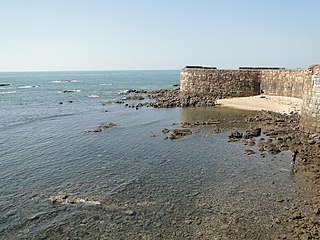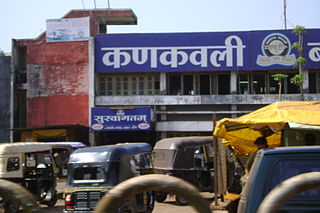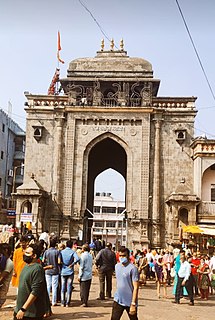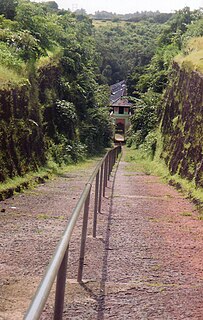
The Krishna River is a river in the Deccan plateau and is the third-longest river in India, after the Ganges and Godavari. It is also the fourth-largest in terms of water inflows and river basin area in India, after the Ganges, Indus and Godavari. The river, also called Krishnaveni, it is 1,400 kilometres (870 mi) long and its length in Maharashtra is 282 kilometres. It is a major source of irrigation in the Indian states of Maharashtra, Karnataka, Telangana and Andhra Pradesh.

The Godavari is India's second longest river after the Ganges river and drains into the third largest basin in India, covering about 10% of India's total geographical area. Its source is in Trimbakeshwar, Nashik, Maharashtra. It flows east for 1,465 kilometres (910 mi), draining the states of Maharashtra (48.6%), Telangana (18.8%), Andhra Pradesh (4.5%), Chhattisgarh (10.9%) and Odisha (5.7%). The river ultimately empties into the Bay of Bengal through an extensive network of tributaries. Measuring up to 312,812 km2 (120,777 sq mi), it forms one of the largest river basins in the Indian subcontinent, with only the Ganga and Indus rivers having a larger drainage basin. In terms of length, catchment area and discharge, the Godavari is the largest in peninsular India, and had been dubbed as the Dakshina Ganga.
Hanga is a village in Parner taluka in Ahmednagar district of the state of Maharashtra.

Sindhudurg district is an administrative district of the Konkan division in India, which was carved out of the erstwhile Ratnagiri district. The district headquarters are located at Oros and the district occupies an area of approximately 5,207 km2 and has a population of 849,651, of which 12.59% were urban. As of 2011, it's the least populous district of Maharashtra.
Kudal is a census town in Sindhudurg district, Maharashtra, India. It is situated on River Karli in southwest Maharashtara. Kudal is the fourth largest town in Sindhudurg after Sawantwadi, Malvan and Kankavli. As of 2011, the population is 16,015. Kudal supports one MIDC area in the Konkan division. The Kudal railway station is located on the Konkan Railway route and connects the town with Mumbai (Bombay) metro situated in the Bombay, Baroda and Central India Railway of the north, and Mangalore on the south. It is a major stop for the Konkan Railway with many trains having a halt. The Deccan Odyssey train also stops in Kudal. National Highway 66 passes through Kudal. Apart from that, it also has two bus stations, a new one and old one. The old one is situated in market while the new one is just adjacent to the NH-66. Kudal is situated in centre of the Sindhudurg district and also considered one of the fastest-growing towns in the Konkan region.

Sangli district is a district of Maharashtra state in India. Sangli city is the district headquarters. It is bordered by Satara district, Solapur district to the North, Karnataka state to South-East, by Kolhapur district to South-West and by narrow portion in East side to Ratnagiri district. It is present on the southern tip of Maharashtra.

Sindhudurg Fort is a historical fort that occupies an island in the Arabian Sea, just off the coast of Maharashtra in Western India. The fort was built by Shivaji Maharaj.The fortress lies on the shore of Malvan town of Sindhudurg District in the Konkan region of Maharashtra, 450 kilometres (280 mi) south of Mumbai. It is a protected monument.
Malvanpronunciation (help·info) is a town and taluka in Sindhudurg District, the southernmost district of Maharashtra State, India, well known for the historically important Sindhudurg Fort. Malvan taluka consists of villages such as Angane Wadi Masure, Achra, Khalchi Devli, Jamdul, Juva, Pankhol, Talasheel and Sarjekot. The main occupation here is fishing and agriculture. The staple diet of the local people is fish curry and rice. The town produces Alphonso mangoes and is also known for sweets such as Malvani Khaja made from gram-besan flour and coated jaggery as well as Malvani Ladoos. Other sweets that attract tourists are Konkani Meva, Aambawadi, Fanaspoli, Kajuwadi, and Naralachya Wadya.

Kankavli is a city in Sindhudurg district in the Indian state of Maharashtra. It is an important city due to its central location in the Sindhudurg district. All talukas are at an equal distance from Kankavli city. There is a temple of Shri Bhalchandra Maharaj and Swyambhu Ravalnath. The Kankavli city is situated in between two west flowing rivers which carry roaring gushing waters on their rockbed to Arabian sea in monsoon. It is a culturally, educationally and socially rich and vibrant major city. A veteran Gandhian Shri Appasaheb Patwardhan founded Gopuri Ashram near Kankavli city with principles of Swadeshi, Swatchhata, Swawlamban and Sarvodaya in 1948. Kankavli is equally located from Kolhapur and Ratnagiri. This is one of the important railway stations on Konkan railway route and major towns on NH 66. Maharashtra's ex- Chief Minister Shri. Narayan Rane also hails from this area.
Gadhinglaj ([ɡəɖᵊɦiŋɡləd͡z]) is a city in India in the Kolhapur district in the southwest corner of the state of Maharashtra, India. It is located on the banks of the river Hiranyakeshi. It is the Taluka (Tehsil) headquarters of Gadhinglaj Taluka and a subdivision headquarters of the Gadhinglaj Subdivision of the Kolhapur District. It is governed by a municipal council. The rapidly growing city is the third largest in the Kolhapur District, with population of more than 50,000. Places to visit like Samagad fort, temples and beautiful weather. Info. By Vinay Gawali.

Devgad is a taluka in Sindhudurg district of Maharashtra India consisting of 98 villages. It is located on the Arabian Sea in the coastal Konkan region of Maharashtra, south of Mumbai. Devgad is known globally for its exports of locally grown Alphonso mangoes.

Tulja Bhavani Temple is a Hindu temple dedicated to goddess Bhavani, also referred to as Durga and Sati. It is located in Tuljapur in Dharashiv district of Maharashtra, India, and is considered as one of the 51 Shakti Pithas. It is situated 45 km from Solapur. The temple was built in 12th century CE by Maratha Mahamandaleshwara Māradadeva of the Kadamb dynasty. The management and priestly rights of the temple are held by the Palikar Bhope clan, the descendants of Māradadeva. Goddess Tulja Bhavani is known by the names Tulaja, Turaja, Tvarita, Durga, Parvati, Tripura Sundari ,Bhagawati,Amba and Jagadambaa in different regions.

Asoli is a small village in Taluka Vengurla and district Sindhudurg of Maharashtra, India.

The Shree Vajreshwari Mata Mandir also known as Kangra Devi Mandir is one of the 51 Shakti Pithas dedicated to the goddess Vajreshvari, a form of Goddess Durga located in the town Kangra in the Northern Indian state of Himachal Pradesh.
Mhapan is a village surrounded by hillocks in Sindhudurg district, Maharashtra, India. Mhapan has its own shoreline, and it is around 12.9 kilometres (8 mi) from the famous Vengurla beach and is just a stone's throw away from the serene beaches of Khavane and Nivati. Mhapan has a population of 5,000. Mhapan panchkroshi contains approximate 15000 population under villages Khavane, Nivati, Malaiee, Kochra, Medha, Shriramwadi and Paat.

Kunkeshwar is a village in Maharashtra, India situated on the bank of Arabian Sea. There is a temple for the Hindu deity Shiva in the village.

Shri Dev Rameshwar Temple is located in village Rameshwar Wadi in Devgad taluka of Sindhudurg District, Maharashtra, India. This temple is dedicated to the Hindu deity Shiva. It is a historic temple built in 16th century. Its chief interest is the approach about 250 yards long, cut through rock fifty feet deep. The idol, a four-armed figure seated on a bull, is of solid silver said to weigh a hundred kilograms and is in good condition at present.

Pujare, also known as Pujar, Pujara or Pujari, traditionally belonged to the priestly class of the Maratha community. They are the original inhabitants of Rameshwar in Devgad Taluka of Sindhudurg District in Maharashtra, India.

Shri Aday Durgay Temple is located near village Rameshwar in Devgad taluka of Sindhudurg District, Maharashtra, India. This temple is dedicated to two Hindu goddesses Aday and Durgay. It is a historic temple that was built even before the 15th century, dedicated to the Clan Goddess or Kuladevata of the Pujare.
Devgad Fort, also called Janjira Devgad Fort, is a fort located 5 km from Devgad town, in Sindhudurg district, of Maharashtra. This fort is an important fort in Sindhudurg district. The fort is surrounded by sea from three side and to the south it is attached to the land.
















